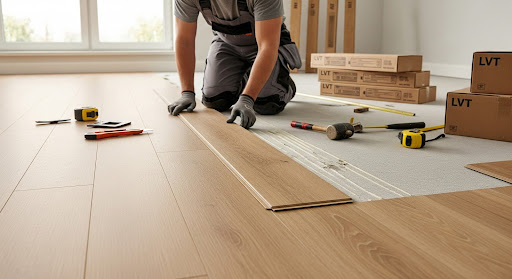That box of vinyl planks sitting in your garage represents more than just a home upgrade, it embodies a classic homeowner’s crossroads. One path leads toward personal accomplishment and potential savings; the other toward guaranteed results and preserved weekends. This choice between doing it yourself and bringing in experts isn’t about capability alone. It’s a complex calculation involving time, skill, budget, and your tolerance for unexpected complications. Understanding which projects suit your abilities and which demand professional intervention can save both your floors and your sanity.
Evaluating Your True DIY Capacity
Honest self-assessment prevents disastrous outcomes. Before tearing up that old carpet, critically examine your relevant skills. Have you successfully completed similar projects? Do you own the necessary tools, or will this require substantial investments in equipment you’ll rarely use again? For those considering luxury vinyl tile, consulting with professional LVT flooring services can provide valuable insight into the project’s complexity. Consider your available time, triple whatever initial estimate you create. Physical capability matters tremendously; flooring installation demands kneeling, bending, and precise cutting motions that challenge even fit individuals.
Understanding Project Complexity Levels
Not all flooring projects share equal difficulty. Interlocking laminate planks floating over a subfloor offer relatively straightforward installation, often manageable for determined novices. However, intricate patterns like herringbone wood, moisture-prone areas like bathrooms, or materials requiring specialized adhesives present significantly greater challenges. Precise seam sealing or complex transitions between rooms frequently benefit from experienced hands. Even seemingly simple installations become complicated when dealing with uneven subfloors or structural irregularities.
Calculating Real Costs Beyond Materials
Focusing solely on material prices creates misleading comparisons. While DIY appears cheaper initially, hidden expenses accumulate quickly. Tool rentals or purchases add substantial costs. Mistakes waste materials, an expensive reality when using quality flooring. Professionals purchase materials at trade discounts often offsetting portions of their labor fees. Their experience prevents costly errors and ensures correct installation methods that protect your investment.
Recognizing Professional Necessity
Certain situations practically demand expert involvement. Structural subfloor repairs requiring joist leveling or moisture barrier installation need specialized knowledge. Complex installations like intricate tile patterns or wide-plank hardwood often justify hiring professionals. Their expertise handles challenging layouts, custom cuts, and seamless transitions that DIY installations often struggle to execute flawlessly.
Weighing Timeline and Convenience Factors
Professional crews complete projects in days rather than weeks. They manage debris removal, material logistics, and unexpected complications efficiently. Contrast this with DIY endeavors that typically expand to fill available time, often stretching across weekends while living in disarray. The convenience of returning to a finished, clean space without consuming your personal time holds significant value.
Considering Long-Term Value Implications
Quality installation affects both durability and resale value. Potential homebuyers notice poorly executed flooring, gapped seams, uneven transitions, or visible cut lines diminish perceived quality. Professional installations often include warranties covering both materials and workmanship, adding value should you sell your home. Incorrectly installed flooring may require premature replacement, negating any initial savings from DIY efforts.
Making Your Final Decision
Let your specific situation guide this choice rather than general principles. Straightforward laminate in a simple square room? Perhaps tackle that yourself. Entire home renovation involving multiple flooring types with complex transitions? Probably worth professional quotes. High-moisture areas or structural complications? Definitely hire experts. Obtain multiple estimates, clearly communicating your project scope.
Trust your instincts after gathering necessary information. If the project consistently feels overwhelming during research, it likely exceeds current capabilities. There’s no shame in hiring experts; their skills ensure beautiful, functional results that last for years. Conversely, successfully completing a manageable DIY installation brings immense satisfaction and practical knowledge for future projects. Whatever path you choose, prioritize proper preparation, quality materials, and realistic expectations for both the process and the outcome.












